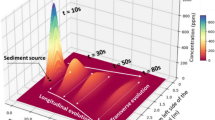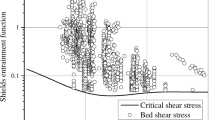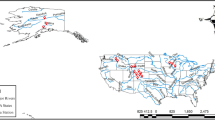Abstract
In natural free surface flows, sediment particles in the surface layer of a sediment bed are moved and entrained by the fluctuating hydrodynamic forces, such as lift and drag, exerted by the overlying flow. Accurate prediction of near-bed hydrodynamic forces in rapidly varied flows is vital for coastal sediment transport and morphodynamics. Directly measured hydrodynamic forces within the rapidly varied flows over rough bed layer have been limited by previous spatial averaging shear force studies. Therefore, the direct measurements were designed and adapted to estimate tidal bore forces, including longitudinal (drag) and vertical (lift) force on near-bed sediment particle. Specially designed experiments were conducted to measure the instantaneous forces using a highly sensitive force sensor assembled with a target sphere. A novel 1D-CNN model (i.e. SedimentNet) has been developed for the prediction of hydrodynamic forces and compared with existing machine learning models (i.e. Decision Tree (DT), Random Forest (RF), Multilayer Perceptron (MLP), Support Vector Regressor (SVR), XGBoost, \(k\)-Nearest Neighbour (\(k\)-NN)). The parameters affecting near-bed hydrodynamic forces are also analysed. In the context of machine learning, both conventional dataset split and fivefold cross-validation approaches were implemented. The results indicated that the proposed SedimentNet was able to achieve marginally better cross-validation performance (i.e. \({R}^{2}\) score of 0.77 for drag force, \({R}^{2}\) score of 0.96 for lift force) for the prediction of drag and lift forces. RF and XGBoost were the second best models with \({R}^{2}\) score of 0.73 and 0.95 for drag and lift force prediction, respectively. Results also showed the potential of machine learning models for the efficient prediction of complex hydrodynamic forces in a coastal environment. A use-case edge computing solution for the reported machine learning-based prediction of hydrodynamic forces has also been proposed and discussed to demonstrate the practical implementability of the presented research.
















Similar content being viewed by others
Data availability
The authors confirm that the data supporting the findings of current study are available within the article. Raw data that support the findings of current study are available from the corresponding author, upon reasonable request.
References
Riaz MZB et al (2022) Performance evaluation of force transducer for the observation of sediment entrainment in rapidly varied flows. J Atmos Oceanic Tech 39(10):1579–1589
Cao D, Chiew Y-M, Yang S-Q (2016) Injection effects on sediment transport in closed-conduit flows. Acta Geophys 64(1):125–148
Foster, D., et al., Field evidence of pressure gradient induced incipient motion. Journal of Geophysical Research: Oceans, 2006. 111(C5).
Yang CT, Marsooli R, Aalami MT (2009) Evaluation of total load sediment transport formulas using ANN. Int J Sedim Res 24(3):274–286
Yang S-Q et al (2020) Three-dimensional velocity distribution in straight smooth channels modeled by modified log-law. J Fluids Eng. https://doi.org/10.1115/1.4044183
Emadzadeh A, Chiew YM, Afzalimehr H (2010) Effect of accelerating and decelerating flows on incipient motion in sand bed streams. Adv Water Resour 33(9):1094–1104
Lee H, Balachandar S (2012) Critical shear stress for incipient motion of a particle on a rough bed. J Geophys Res: Earth Surface 117(F1):1–19
Dwivedi A et al (2011) Flow structures and hydrodynamic force during sediment entrainment. Water Resour Res 47(1):1–18
Riaz MZB et al (2021) Direct measurements of hydrodynamic forces induced by tidal bores. Water Resour Res 57(4):e2020WR028970
Schmeeckle MW, Nelson JM, Shreve RL (2007) Forces on stationary particles in near-bed turbulent flows. J Geophys Res-Part F-Earth Surf 112(F2):1–21
Einstein HA, El-Samni E-SA (1949) Hydrodynamic forces on a rough wall. Rev Mod Phys 21(3):520
Zeng L et al (2008) Interactions of a stationary finite-sized particle with wall turbulence. J Fluid Mech 594:271–305
Derksen J, Larsen R (2011) Drag and lift forces on random assemblies of wall-attached spheres in low-Reynolds-number shear flow. J Fluid Mech 673:548–573
Detert M, Weitbrecht V, Jirka GH (2010) Laboratory measurements on turbulent pressure fluctuations in and above gravel beds. J Hydraul Eng 136(10):779–789
Riaz, M.Z.B., S.-Q. Yang, and M. Sivakumar, (2021) Laboratory measurements of velocity and hydrodynamic force over coarse fixed rough bed, in ICHWR CEWRE
Frank D et al (2015) Incipient motion of surf zone sediments. J Geophys Res: Oceans 120(8):5710–5734
Riaz, M.Z.B., S.-Q. Yang, and M. Sivakumar, (2021) Hydrodynamic forces generated on a coarse spherical particle beneath a tidal bore, in webinar on experimental methods and laboratory instrumentation in Hydraulics. InstGeoph PAS_Publs
Goldstein EB, Coco G (2014) A machine learning approach for the prediction of settling velocity. Water Resour Res 50(4):3595–3601
Solomatine DP, Shrestha DL (2009) A novel method to estimate model uncertainty using machine learning techniques. Water Resour Res. https://doi.org/10.1029/2008WR006839
Iqbal, U., et al., Prediction of Hydraulic Blockage at Cross Drainage Structures using Regression Analysis. arXiv preprint arXiv:2103.10930, 2021.
Lal A, Datta B (2021) Application of the group method of data handling and variable importance analysis for prediction and modelling of saltwater intrusion processes in coastal aquifers. Neural Comput Appl 33(9):4179–4190
Dawood M, Asif A (2020) Deep-PHURIE: deep learning based hurricane intensity estimation from infrared satellite imagery. Neural Comput Appl 32(13):9009–9017
Iqbal U et al (2022) Prediction of hydraulic blockage at culverts using lab scale simulated hydraulic data. Urban Water J 19(7):686–699
Roshni T, Jha MK, Drisya J (2020) Neural network modeling for groundwater-level forecasting in coastal aquifers. Neural Comput Appl 32:1–18
Jiang R, Zhao K (2021) Using machine learning method on calculation of boundary layer height. Neural Comput Appl 34:1–13
Yang S-Q (2019) Formula for sediment transport subject to vertical flows. J Hydraul Eng 145(5):04019013
Lamb MP, Brun F, Fuller BM (2017) Direct measurements of lift and drag on shallowly submerged cobbles in steep streams: implications for flow resistance and sediment transport. Water Resour Res 53(9):7607–7629
Breiman L et al (2017) Classification and regression trees. Routledge, London
Breiman L (2001) Random forests. Mach Learn 45(1):5–32
Li Y et al (2018) Random forest regression for online capacity estimation of lithium-ion batteries. Appl Energy 232:197–210
Abraham, A., Artificial neural networks. Handbook of measuring system design, 2005.
Mehrotra K, Mohan CK, Ranka S (1997) Elements of artificial neural networks. MIT press, Cambridge
Krogh A (2008) What are artificial neural networks? Nat Biotechnol 26(2):195–197
Basheer IA, Hajmeer M (2000) Artificial neural networks: fundamentals, computing, design, and application. J Microbiol Methods 43(1):3–31
Boser BE, Guyon IM and Vapnik VN (1992) A training algorithm for optimal margin classifiers. In: Proceedings of the fifth annual workshop on Computational learning theory.
Fix E, Hodges JL (1989) Discriminatory analysis nonparametric discrimination: consistency properties. Int Stat Rev/Rev Int de Stat 57(3):238–247
Chen T et al (2015) Xgboost: extreme gradient boosting. R Package Version 1(4):1–4
Abba SI et al (2020) Implementation of data intelligence models coupled with ensemble machine learning for prediction of water quality index. Environ Sci Pollut Res 27(33):41524–41539
Iqbal U et al (2021) Automating visual blockage classification of culverts with deep learning. Appl Sci 11(16):7561
García-Gutiérrez J et al (2015) A comparison of machine learning regression techniques for LiDAR-derived estimation of forest variables. Neurocomputing 167:24–31
Barthélemy J et al (2019) Edge-computing video analytics for real-time traffic monitoring in a smart city. Sensors 19(9):2048
Barthelemy J et al (2020) Problem-driven and technology-enabled solutions for safer communities: the case of stormwater management in the Illawarra-Shoalhaven region (NSW, Australia) Handbook of Smart Cities. Springer, Cham, pp 1–28
Arshad B, et al. (2020) Where is my deer?-wildlife tracking and counting via edge computing and deep learning. In: 2020 IEEE SENSORS. IEEE
Microsonic, Ultrasonic Displacement Sensor. Available: https://www.microsonic.de/en/distance-sensors/cylindrical/micplus.htm. 2022
Dantecdynamic, Fluid Mechanics. Available: https://www.dantecdynamics.com/solutions-applications/solutions/fluid-mechanics/. 2022
NVIDIA., Jetson Xavier NX Series. Available: https://www.nvidia.com/en-au/autonomous-machines/embedded-systems/jetson-xavier-nx/. 2022
Waveshare, SIM8200EA-M2 5G Module Designed for Jetson Nano, 5G/4G/3G, Snapdragon X55, Multi Mode Multi Band. Available: https://www.waveshare.com/sim8200ea-m2-5g-for-jetson-nano.htm. 2022
Acknowledgements
The first author wishes to acknowledge the joint PhD scholarship provided by the Higher Education Commission (HEC) of Pakistan and the University of Wollongong, Australia. The design, construction and waterproofing of the Tainter gate and force transducer were carried out at the workshop and the experiments were conducted in the fluid hydraulics and hydrodynamics laboratory at the University of Wollongong. The authors therefore express their gratitude to the workshop and laboratory technicians Mr. Gavin Bishop, Mr. Travis Marshall, and Mr. Jordan Wallace. Furthermore, Mr. Peter Ihnat’s assistance in LabVIEW programming for data collection and synchronization is highly appreciated.
Author information
Authors and Affiliations
Corresponding author
Ethics declarations
Conflict of interest
The authors declare that they have no known competing financial interest or personal relationships that could have appeared to influence the work reported in this article.
Additional information
Publisher's Note
Springer Nature remains neutral with regard to jurisdictional claims in published maps and institutional affiliations.
Rights and permissions
Springer Nature or its licensor (e.g. a society or other partner) holds exclusive rights to this article under a publishing agreement with the author(s) or other rightsholder(s); author self-archiving of the accepted manuscript version of this article is solely governed by the terms of such publishing agreement and applicable law.
About this article
Cite this article
Riaz, M.Z.B., Iqbal, U., Yang, SQ. et al. SedimentNet — a 1D-CNN machine learning model for prediction of hydrodynamic forces in rapidly varied flows. Neural Comput & Applic 35, 9145–9166 (2023). https://doi.org/10.1007/s00521-022-08176-3
Received:
Accepted:
Published:
Issue Date:
DOI: https://doi.org/10.1007/s00521-022-08176-3




